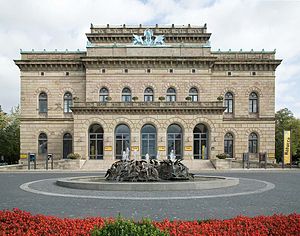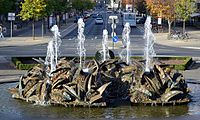State Theater Braunschweig
| State Theater Braunschweig | |

|
|
| location | |
| Address: | At the theater / Steinweg |
| City: | Braunschweig |
| Coordinates: | 52 ° 15 '57 " N , 10 ° 31' 54" E |
| Architecture and history | |
| Construction time: | 1856-1861 |
| Opened: | October 1, 1861 |
| Spectator: | 896 seats |
| Spectators without seats: | 60 seats |
| Architect: |
Carl Heinrich Wilhelm Wolf Carl Friedrich Heinrich Ahlburg Heinrich Seeling (conversion 1902–1904) |
| Internet presence: | |
| Website: | State Theater Braunschweig |
The Braunschweig State Theater is a five-division house in Braunschweig . Every year it shows around 35 premieres in the fields of drama , music theater ( opera , operetta , musical ), dance and in the field of children's and youth theater as a young state theater . The fifth division is the Braunschweig State Orchestra . The Braunschweig State Theater has three venues: the Big House, the Little House and House Three. Since 2003, an open-air stage with around 1,200 seats has been set up and played on Braunschweig's Burgplatz in summer . In November 2017, a fourth venue was opened with the aquarium in the upper foyer of the small house, which - equipped with a bar - shows more experimental forms of theater.
history
Today's Staatstheater Braunschweig is the oldest public multi-branch theater in Germany, its beginnings as a court theater go back to 1690. Duke Anton Ulrich von Braunschweig founded the opera house on Hagenmarkt . The court theater was one of the first publicly accessible theater stages in the German-speaking area and initially a venue for operas. From the 18th century, plays were also performed, including numerous world premieres such as Emilia Galotti (1772) and Faust I (1829). Until the beginning of the 19th century, the theater had no permanent theater ensemble, the stage of the Hagenmarkt Theater was used by traveling troops , which also included the troupe of Friederike Caroline Neuber . In 1818 the stage was elevated to the status of a national theater and received a standing stage with a permanently engaged ensemble. In 1826, however, the theater was downgraded again to the Ducal Court Theater because it no longer met the high requirements of a modern theater business, so that a new theater was started. The opera house on Hagenmarkt was closed in 1861 due to disrepair and demolished in 1864.
The big house
On October 1, 1861, after five years of construction, the Great House, the new venue on Steinweg , was inaugurated. With the construction of the theater, the Ducal Park was divided into two parts, the Theater Park and the Museum Park . During the Second World War , the theater and the Kammerspiele in the Grotrian-Steinweg-Saal were largely destroyed in the bombing on October 15, 1944 . After its restoration, led by Johann Daniel Thulesius , the Great House reopened on December 25, 1948 with a performance by Don Giovanni as one of the first German theaters of the post-war period. There were expansion and reconstruction measures in the years 1970–1972, 1982–1983 and 1988–1989.
- Large house
Other venues
In the Kammerspiele in the Kant-Hochschule was played from September 23, 1945 to July 30, 1949. On December 16, 1949, the small house in the more distant Grünewaldstrasse was initially relocated as a temporary measure. The new Small House (built from 1992 to 1996 under the direction of the Lindemann + Thamm architects) was opened in March 1996 diagonally across from the Large House on Magnitorwall. Since the 2017/2018 season, the Aquarium has also been located here, replacing the former U22.
Other venues are the town hall for symphony concerts and the three house in the Magniviertel, founded as a theater playground and renamed in August 2006 .
Technical specifications
- The large house offers 896 seats and 60 standing places in the hall. The portal width is 12–12 m, the portal height a maximum of 7.3 m. The stage dimensions are 19.5 m × 23.5 m, the height to the Schnürboden is around 21 m. The stage also has eight podiums, including three double-decker podiums and a transport podium as well as several stage trains and a turntable.
- The small house has a maximum of 297 places with a multifunctional room arrangement. The portal width is 8 to 10 meters, the portal height a maximum of 7 m. Stage dimensions 9 m × 11.6 m. The height of the stage is 15.6 m, it has seven podiums.
- Haus Drei has 80 seats, the aquarium 87 and the town hall (built in 1965, architects Heido Stumpf and Peter Voigtländer) in the Great Hall has 2300 seats.
Others
- The owner is the state of Lower Saxony , which pays subsidies, the city of Braunschweig is involved in this.
- The Staatstheater Braunschweig has been one of the hosts of the international Theaterformen festival since 1990, alternating two years with the Staatstheater Hannover .
- The “Escape to Life” theme days will take place for the first time in the 2017/18 season.
Artistic director since 1925
- 1925–1929: Ludwig Neubeck
- 1929–1933: Thur Himmighoffen
- 1933–1934: Oskar Walleck
- 1934–1945: Alexander Schum
- 1945–1946: Jost Dahmen
- 1946–1947: Heinrich Voigt
- 1947–1951: Walter Bruno Iltz
- 1951–1961: Hermann Kühn
- 1961–1963: Erich Kriebig
- 1964–1967: Hellmuth Matiasek
- 1967–1968: Hermann Kühn
- 1968–1972: Hans Peter Doll
- 1972–1979: Christoph Groszer
- 1979–1991: Mario Krüger
- 1992–1993: Hans Peter Doll
- 1993–1995: Jürgen Flügge
- 1995–1997: Executive committee: Brigitte Fassbaender , Philippe Auguin , Tatjana Rese
- 1997–2010: Wolfgang Gropper
- 2010–2017: Joachim Klement
- from 2017: Dagmar Schlingmann
literature
- Claus-Henning Bachmann, Gertrud Frank: 275 years of theater in Braunschweig. Staatstheater Braunschweig, Braunschweig 1965, DNB 455034192 .
- Gerd Biegel (Ed.): 300 years of theater in Braunschweig 1690–1990. Joh. Heinr. Meyer Verlag, Braunschweig 1990, ISBN 978-3-926701-11-4 .
- Daniela Brendel (editor): Thirteen seasons - General Manager Wolfgang Gropper. Appelhans, Braunschweig 2010, ISBN 978-3-941737-23-5 .
- Ilona Büttenbender: Braunschweig theater life from 1690 to today. History - thoughts - conversations. Joh. Heinr. Meyer Verlag, Braunschweig 1988.
- Wolfgang Gropper , Peter Schanz (Hrsg.): A Braunschweigische Dramaturgie: Plays for this city. Appelhans, Braunschweig 2007, ISBN 978-3-937664-72-9 .
- Bernhard Struckmeyer: The play at the court theater Braunschweig from 1890 to 1918. in: Braunschweiger Werkstücke. Volume 4/41, Braunschweig 1969.
Theater magazines:
- Almanac of the Duke of Braunschw. Court theater. Ramdohr, Braunschweig from 1907, DNB 015215822 .
- Playtime. Staatstheater Braunschweig, Braunschweig from 1963, DNB 018009093 .
Web links
- Internet presence of the State Theater Braunschweig at Staatstheater-braunschweig.de
- Videos of current productions on Staatstheater-braunschweig.de
- News from the State Theater on bs-live.de
- Staatstheater Braunschweig on braunschweig.de
Individual evidence
- ↑ a b c performance venues at Staatstheater-braunschweig.de, accessed on May 15, 2013.
- ^ State theater with Cimiotti fountain on braunschweig.de, accessed on October 7, 2015
- ↑ Venues. Retrieved November 21, 2018 .
- ↑ In the same building complex as the Integrated Comprehensive School Franzsches Feld .
- ↑ About us ( Memento from July 13, 2010 in the Internet Archive ) on theaterformen.de, accessed on May 15, 2013.
- ↑ a b Hans Peter Doll in the city chronicle Braunschweig 1999 ( online ( page no longer available , search in web archives ))
- ↑ Jürgen Flügge at Theaterakademie Mannheim ( Online ( Memento from January 5, 2010 in the Internet Archive ))




